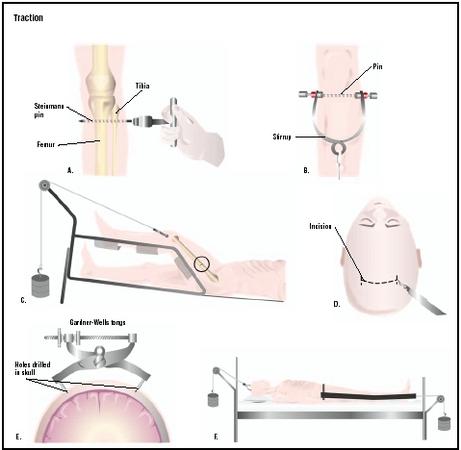Traction
Definition
Traction is force applied by weights or other devices to treat bone or muscle disorders or injuries.
Purpose
Traction treats fractures, dislocations, or muscle spasms in an effort to correct deformities and promote healing.
Description
Traction is referred to as a pulling force to treat muscle or skeletal disorders. There are two major types of traction: skin and skeletal traction, within which there are a number of treatments.
Skin traction
Skin traction includes weight traction, which uses lighter weights or counterweights to apply force to fractures or dislocated joints. Weight traction may be employed short-term, (e.g., at the scene of an accident) or on a temporary basis (e.g., when weights are connected to a pulley located above the patient's bed). The weights, typically weighing five to seven pounds, attach to the skin using tape, straps, or boots. They bring together the fractured bone or dislocated joint so that it may heal correctly.
In obstetrics, weights pull along the pelvic axis of a pregnant woman to facilitate delivery. In elastic traction, an elastic device exerts force on an injured limb.
Skin traction also refers to specialized practices, such as Dunlop's traction, used on children when a fractured arm must maintain a flexed position to avoid circulatory and neurological problems. Buck's skin traction stabilizes the knee, and reduces muscle spasm for knee injuries not involving fractures. In addition, splints, surgical collars, and corsets also may be used.
Skeletal traction
Skeletal traction requires an invasive procedure in which pins, screws, or wires are surgically installed for use in longer term traction requiring heavier weights. This is the case when the force exerted is more than skin traction can bear, or when skin traction is not appropriate for the body part needing treatment. Weights used in skeletal traction generally range from 25–40 lbs (11–18 kg). It is important to place the pins correctly because they may stay in place for several months, and are the hardware to which weights and pulleys are attached. The pins must be clean to avoid infection. Damage may result if the alignment and weights are not carefully calibrated.
Other forms of skeletal traction are tibia pin traction, for fractures of the pelvis, hip, or femur; and overhead arm traction, used in certain upper arm fractures. Cervical traction is used when the neck vertebrae are fractured.

Proper care is important for patients in traction. Prolonged immobility should be avoided because it may cause bedsores and possible respiratory, urinary, or circulatory problems. Mobile patients may use a trapeze bar, giving them the option of controlling their movements. An exercise program instituted by caregivers will maintain the patient's muscle and joint mobility. Traction equipment should be checked regularly to ensure proper position and exertion of force. With skeletal traction, it is important to check for inflammation of the bone, a sign of foreign matter introduction (potential source of infection at the screw or pin site).
Preparation
Both skin and skeletal traction require x rays prior to application. If skeletal traction is required, standard pre-op surgical tests are conducted, such as blood and urine studies. X rays may be repeated over the course of treatment to insure that alignment remains correct, and that healing is proceeding.
Normal results
There have been few scientific studies on the effects of traction. Criteria (such as randomized controlled trials and monitored compliance) do exist, but an outcome study incorporating all of them has not yet been done. Some randomized controlled trials emphasize that traction does not significantly influence long-term outcomes of neck pain or lower back pain.
Resources
books
"Cervical Spine Traction." In Noble: Textbook of Primary Care Medicine, 3rd ed.Mosby, Inc., (2001): 1132.
periodicals
Glick, J.M. "Hip Arthroscopy. The Lateral Approach." Clinics in Sports Medicine 20, no.4 (October 1, 2001): 733-41.
Overly, M.D., Frank and Dale W. Steele, M.D. "Common Pediatric Fractures and Dislocations." Clinical Pediatric Emergency Medicine 3, no.2 (June 2002).
Nancy McKenzie, Ph.D.
QUESTIONS TO ASK THE DOCTOR
- How long will traction be required?
- What are the risks and benefits?
- What is the goal of traction?
- What is the chance of complications?
this site is very effective and good.it helps a lot and give much benefits to surgeon.
what physics concept applied it?
Isn't this a contraindication to perform traction.
A: Red flags indicative of a serious or non-musculoskeletal condition (i.e. tumor, fracture, metabolic diseases, RA, osteoporosis, prolonged history of steroid use, etc.)
whatis nursing intervention for patient with traction?
if there are other types, mention .
thank you.
could you please tell me do youu have any thing in this area?
i will apply this teory in my practical area.thanks a lot..